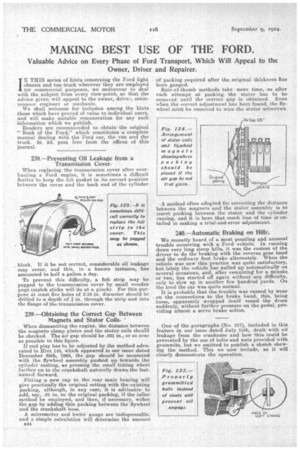MAKING BEST USE OF THE FORD.
Page 28

If you've noticed an error in this article please click here to report it so we can fix it.
Valuable Advice on Every Phase of Ford Transport, Which Will Appeal to the Owner, Driver and Repairer.
IN THIS series of hints concerning the Ford light chassis and ton truck wherever they are employed tor commercial purposes, we endeavour to deal with the subject from every view-point, so that the advice given will appeal to the owner, drive:, maintenance engineer or mechanic.
We shall welcome for inclusion among the hints those which have proved of value to individual users, and will make suitable remuneration for any such information which we publish. Readers are recommended to obtain the original " Book of the Ford," which constitutes a complete manual dealing with the Ford car, the van and the truck. 2s. 9d. post free from the offices of this journal.
238.—Preventing Oil Leakage from a Transmission Cover.
When replacing the transmission cover after Over hauling a Ford engine, it is sometimes a difficult ?natter to keep the felt gasket in its correct position between the cover and the back end of the cylinder block. If it be not correct, considerable oil leakage may occur, and this, in a known instance, has amounted to half a gallon a day.
To prevent this difficulty, a felt strip may be pegged to the transmission cover by small wooden pegs (match sticks will do at a pinch). For this purpose at least five holes of 3-32 in. diameter should he drilled to a depth of I in. through the strip and into the flange of the transmission cover.
239.—Obtaining the Correct Gap Between Magnets and Stator Coils. •
When dismantling the engine, the distance between the magneto clamp plates and the stator coils should be checked. The air gap should be .031 in., or as near as possible to this figure.
If end play has to be adjusted by the method advocated in Hint 148, which appeared in our issue dated December 25th, 1923, the gap should be measured with the flywheel assembly pushed up towards the cylinder casting, as pressing the small timing wheel farther on to the crankshaft naturally draws the lastnamed forward.
Fitting a new cap to the rear main bearing will give practically the original setting with the existing packing, although, in any case, it is advisable to Add, say, .01 in. to the original packing, if the laaer method be employed, and then, if necessary, widen the gap by adding thin packing between the flywheel and the crankshaft boss.
A micrometer and feeler gauge are indispensable, and a simple calculation will determine the amount B44
of packing required after the original thickness has been gauged.
Rule-of-thumb methods take more time, as after each attempt at packing the stator has to be removed until the correct gap is obtained. Even when the correct adjustment has been found, the flywheel must be removed to wire the stater setscrews.
A method often adopted for correcting the distance between the magnets and the stator assembly is to insert packing between the stator and the cylinder casting, and it is here that much loss of time is entailed in making a trial-and-error adjustment.
240.—Automatic Braking on
We recently heard of a most puzzling and unusual trouble occurring with a Ford vehicle. In running down very long steep .hills, it was the custom of the driver to do the braking with the reverse gear band and the ordinary foot brake alternately. When the vehicle was new this practice was quite satisfactory, but lately the vehicle 'has pulled up automatically on several occasions, and, after remaining for a minute or two, has started off again without any difficulty, only to slow up in another few hundred yards. On the level the car was quite normal.
It is probable that the trouble was caused by wear on the connections to the brake band, this, being loose, apparently wrapped itself round the drum suddenly, without further pressure on the pedal, providing almost a servo brake action.
One of the paragraphs (No. 217), included in this feature in our issue dated july 15th, dealt -with oil leakage from the crankcase and how this could be prevented by the use of bolts and nuts provided with grummits, but we omitted to publish a sketch showing the method. This we now include, as it will clearly demonstrate the operation.
































